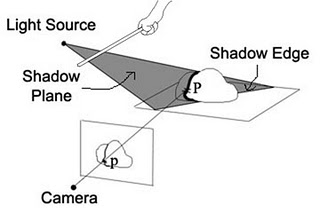There’s a relatively straightforward approach for making an inexpensive 3D scanner using stuff you probably are sitting beside right now, and several websites detail methods of doing so, some even including software you can use yourself.
The approach is described by Jean-Yves Bouguet and Pietro Perona of the California Institute of Technology, who propose “shadow scanning”. In this approach, a shadow is repeatedly imaged at an extreme angle as it slowly passes over a 3D object. Software interprets the shadow position differences and derives the 3D model. The diagram above explains it a lot better.
Via CalTech and the University of Washington (Hat Tip to Massimo Menichinelli)



![Reblog this post [with Zemanta]](http://img.zemanta.com/reblog_e.png?x-id=b96b221b-1bca-43a6-a52a-3d779e882385)
Ops! All fixed, TYVM!
Great find, just a note that your U of W link needs a space taken off the end to work.